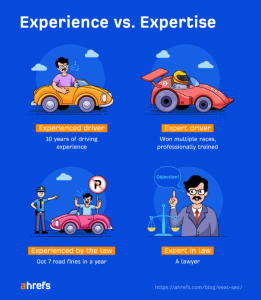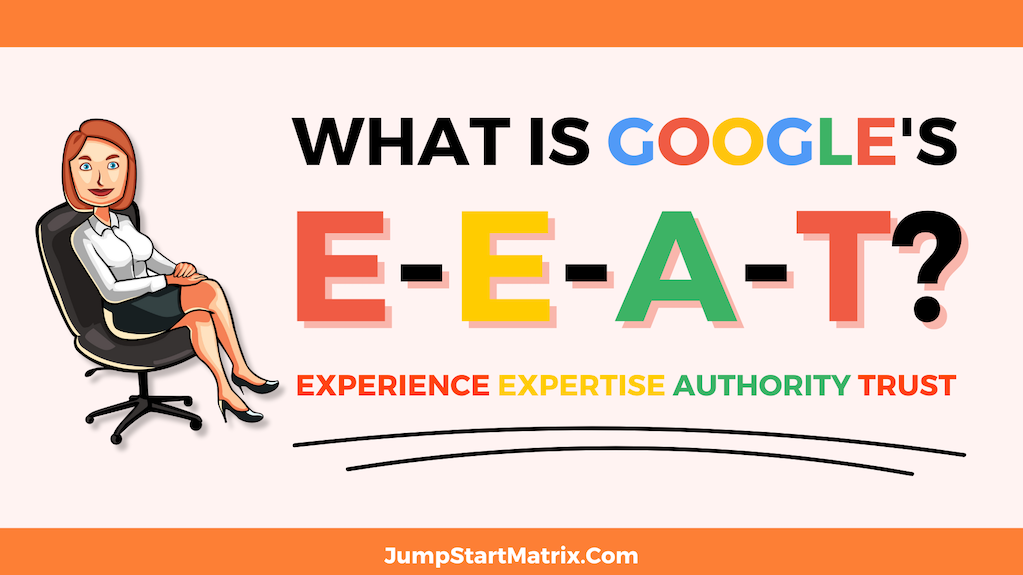Google explains “Many creators are familiar with the concept of E-A-T, which is used in how we evaluate if our search ranking systems are providing helpful, relevant information.
Would ordinary people feel the results they get demonstrate E-A-T, that is: expertise, authoritativeness, and trustworthiness?
Now to better assess our results, E-A-T is gaining an E: experience. Does content also demonstrate that it was produced with some degree of experience, such as with actual use of a product, having actually visited a place or communicating what a person experienced?”
What does E-E-A-T mean?
Google introduced their (updated) concept of E-E-A-T, which stands for
- Experience.
- Expertise.
- Authoritativeness.
- Trustworthiness.

However, Trust is the most critical component of E-E-A-T, Google says, “because untrustworthy pages have low E-E-A-T no matter how Experienced, Expert, or Authoritative they may seem.”
Search Engine Land wrote a great post on why E-E-A-T matters for SEO ( Search Engine Optimisation)
“Google recently added an extra “E” to the search quality standards of E-A-T to ensure content is helpful and relevant. The extra “E” stands for “experience” and precedes the original E-A-T concept – expertise, authoritativeness and trustworthiness.
We know that E-A-T was already of high importance. Hyung-Jin Kim, VP of Search at Google, confirmed this at SMX Next:
“E-A-T is a template for how we rate an individual site. We do it to every single query and every single result. It’s pervasive throughout every single thing we do.”
To rank at Google’s SERPs, you must demonstrate E-E-A-T in your content strategy. …
Google wants to provide accurate information to its users, so to gain traction in SERPs and get your site to the top spots, you need to demonstrate E-E-A-T.
Demonstrating E-E-A-T to Google
SEO is highly accountable for delivering what’s needed to meet E-E-A-T standards, but what does it mean exactly and how do you prove experience, expertise, authoritativeness and trustworthiness?
The good news is most conscientious website administrators, SEOs, and marketing teams are already doing what they need to and developing E-E-A-T right now.”
Search Engine Journal expands further on the whole concept and what comes into play:
Experience, expertise, and authoritativeness support a quality rater’s trust assessment.
If you’re following Google’s guidance regarding E-A-T up to this point, you’re well on your way to building the level of trust Google’s quality raters are looking for.
Here’s how to ensure you maintain that trust by demonstrating first-hand experience.
How Google’s Quality Raters Evaluate E-E-A-T
Google’s search quality rater guidelines have multiple chapters evaluating E-E-A-T, from a high to a low level.
Chapter 4.5.2:Lowest E-E-A-T
Chapter 4.5.2 of Google’s search quality rater guidelines states:
“If the E-E-A-T of a page is low enough, people cannot or should not use the MC of the page. If a page on YMYL topics is highly inexpert, it should be considered Untrustworthy and rated Lowest. Use the Lowest rating if the website and content creator have an extremely negative reputation, to the extent that many people would consider the webpage or website untrustworthy.”
Chapter 7.3: High Level of E-E-A-T
Chapter 7.3 of Google’s quality rater guidelines has information regarding the criteria for achieving a high level of E-E-A-T.
Regarding demonstrating experience, Google says:
“Pages with High E-E-A-T are trustworthy or very trustworthy. Experience is valuable for almost any topic. Social media posts and forum discussions are often High quality when they involve people sharing their experience. From writing symphonies to reviewing home appliances, first-hand experience can make a social media post or discussion page High quality.”
Ahrefs blog post explains more about “Experience” vs “Expertise” in E-E-A-T
Google’s general idea here is to reward (rank higher) quality content that comes from trusted sources. So the messenger is at least as important as the message.
How Google understands ‘Experience’

Experience in the Double-E-A-T means first hand or life experience in the topic.
This means that Google will aim to “reward” pages where the author has actually experienced the topic they are writing about. For example:
-
- For an iPhone review, the author must have actually used the product.
- For a guide on the best jazz bars in San Francisco, the author must have actually visited them.
- For an overnight oatmeal recipe, the author must have actually made the dish.
- For an article on how to help people mentally cope with an illness, the author must have actually gone through it personally and/or helped other people.
- For a guide on how to be successful in business… you get the idea.
Let’s break down E-E-A-T and see how SEO can influence it with the above guidelines in mind.
Experience
Think of lived experience – specifically, first-hand experiences on the topic you’re writing about.
Experience is especially important in a digital world moving toward generative AI content.
AI can never demonstrate true experiences of anything. At best, it can make assumptions about the human experience, but the content it generates won’t be unique.
It’s probably no coincidence that Google announced the addition of “experience” in its search quality raters guidelines shortly after ChatGPT’s launch.
Experience is a core differentiator between human- and AI-written content.’
Get help NOW with your Site and Content- Book that Free Call!
What does E-E-A-T have to do with SEO?
What is the best way to demonstrate to Google (and potential clients) that YOU have ” Experience & Expertise” in your niche and that they can trust you?
Content!
On all online channels you have set up; written, images, video, Instagram Reels and Facebook Carousels/Posts etc
For the team at JumpStart Matrix, / myself, this often translates into me badgering (or pleading) with site owners to WRITE MORE RELEVANT CONTENT to help their SEO.
Of course, every site owner is also running a business or has a job – sometimes both. Time is precious.
This often means we have to write that content for them.
This involves research and sourcing great images we have permission to use- all of which takes time.
JumpStart Matrix writes a lot of content for their clients to help with E-E-A-T.
But that content must be presented in the right way to do well with the Search Engines (like Google) algorithms using ‘On page’ and ‘Off page’ SEO
‘On page’ means what you may assume: have you optimised your Page or Post i.e. got great content that educates and informs, correct h tags, relevant keywords, internal linking, good images (with Alt text) and more With the amount of content out there now, it is not sufficient to throw up 300-400 words and think that will do much for you, especially with E-E-A-T
( Note: Although I can be heard saying to clients ( and myself!) 300-400 words is MUCH better than NO words Published/Posted )
Off-page SEO is leveraging other (preferably authority in your topic) sites/places with external linking, Social Media across the web to assist improve your position within search rankings.
Having ‘best practice’ On Page SEO is most important to focus on initially- but both work in synergy.
Backlinko has a good guide if you want to read / understand On Page and Off Page SEO in more depth
Backlinko explain the difference in a nutshell this way:
On-Page SEO vs. Off-Page SEO
On-page SEO is everything that you can directly control on your website, including content, title tags, keyword usage, SEO-optimized URLs, internal links and image alt text.
Off-page SEO are actions that happen away from your website, like links and mentions on other websites.
Backlinko’s Brian Dean is the master of long form copy- Take note!
A good wrap up provided by SetupPad:
However, E-E-A-T helps to determine credibility, and by collecting the feedback from Quality Raters, Google can further evaluate if a website brings real value to the user. Therefore, following E-E-A-T principles helps to create high-quality content, which is vital for your Google ranking.
Generally, E-E-A-T is another way to provide better UX on search engines, and that’s what Google constantly tries to improve. For example, they developed Core Web Vitals for a faster and smoother UX. (User Experience)
There is so much more to write on regarding all the nuances.
But my aim was to get you to understand WHY this is vital – IF you want YOUR website to be shown more by Google ( and all the other Search Engines)
Any potential customer will also respond well when you seem competent, credible and Trustworthy with the content on your site.
Need help NOW?
No time to write? We can Help! Call NOW
You should also know about Google’s “Helpful Content ‘Update!



